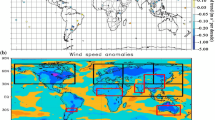Abstract
Variations in wind speed and air temperature during blowing snow are considered in detail using data from the Canadian weather observation network with high spatiotemporal resolution. It is revealed that blowing snow considerably affects the lower atmospheric layer regime. The analysis of observational data illustrates the fact of wind speed increase during the snowstorm. The local minima of air temperature during the period of blowing snow are identified. The method is determined for calculating the threshold wind speed that provokes the onset of blowing snow. The highest skill scores were obtained for the method which takes into account air temperature and humidity.
Similar content being viewed by others
References
G. I. Barenblatt, "On the Moiion of Suspended Particles in the Turbuient Flow," Prikladnaya Matematika i Mekhanika, No. 3, 17 (1953) [in Russian].
G. I. Barenblatt and G. S. Golitsyn, Local Structure of Developed Dust Storms (MGU, Moscow, 1973) [in Russian].
E. K. Byutner, Dynamics of Surface Air Layer (Gidrometeoizdat, Leningrad, 1978) [in Russian].
N. F. Vel'tishchev, Mesometeorology and Short-range Forecasting. Lecture Notes and Students' Workbook for Training, WMO-No. 701 (Gidrometeoizdat, Leningrad, 1988) [in Russian].
K. F. Voitkovskii, Avalanche Studies (MGU, Moscow, 1989) [in Russian].
Glaciological Dictionary, Ed. byV. M. Kotlyakov (Gidrometeoizdat, Leningrad, 1984) [in Russian].
D. M. Gray and D. H. Male, Handbook of Snow (Gidrometeoizdat, Leningrad, 1986) [Transl. from English].
N. E. Dolgov, Snow Control on the Russian Railroads, Issue 1 (Ekaterinoslav, 1909) [in Russian].
A. K. Dyunin, In the Kingdom of Snow (Nauka, Novosibirsk, 1983) [in Russian].
A. K. Dyunin, Evaporation of Snow (SO AN SSSR, Novosibirsk, 1961) [in Russian].
A. K. Dyunin, Snowstorm Mechanics (Sibirskoe Otdelenie AN SSSR, Novosibirsk, 1963) [in Russian].
A. S. Zverev, Synoptic Meteorology (Gidrometeoizdat, Leningrad, 1977) [in Russian].
E. D. Zolotnitskii, "Snowdrifts," Zhurnal Ministerstva Putei Soobshcheniya, Vol. 4, Book 1 (1878) [in Russian].
N. A. Kazakov, "A Methodology for Calculation of Risks Related to Avalanches and Mudflows on Territories, Facilities, and Constructions," Georisk, No. 1 (2015) [in Russian].
V. M. Kotlyakov, "Snow Drifting in Antarctica and Its Role in the Glacier Alimentation Balance," in Geography of Snow Cover (AN SSSR, Moscow, 1960) [in Russian].
P. P. Kuz'min, Physical Properties of Snow Cover (Gidrometeoizdat, Leningrad, 1957) [in Russian].
A. S. Monin and A. M. Obukhov, "Fundamental Principles of Turbulent Mixing in the Atmospheric Surface Layer," Trudy Instituta Fiziki Atmosfery, No. 151 (1954) [in Russian].
G. D. Rikhter, Snow Cover: Formation and Properties (AN SSSR, Moscow, 1945) [in Russian].
I. N. Rusin and G. G. Tarakanov, Short-range Weather Forecasting (RGGMU, St. Petersburg, 1996) [in Russian].
N. A. Rynin, "Studying Snow Protection Activities," Sbornik Instituta Inzhenerov Putei Soobshcheniya, No. 89 (Petrograd, 1915) [in Russian].
O. E. Semenov, "Flow Acceleration during Severe Sand and Dust Storms," Gidrometeorologiya i Ekologiya, No. 3-4 (2000) [in Russian].
O. E. Semenov, "Resisiance of Mobile Sand Surface during Storms," Gidrometeorologiya i Ekologiya, No. 1 (2002) [in Russian].
V. E. Suchkov, Contribution of Snow Drifting to Redistribution of Snow Cover and Formation of Snow Fields, Glaciers, and Avalanches on Sakhalin and theKurileIslands, Thesis Abstract (VGI, Nalchik, 2012) [in Russian].
F. I. Frankl', "To the Theory of Motion of Suspended Load," Doklady AN SSSR, No. 2, 92 (1953) [in Russian].
F. I. Frankl', "Energy Equations for the Motion of Fluids with Suspended Load," Doklady AN SSSR, No. 5, 102 (1955) [in Russian].
F. I. Frankl', The System of Equations of Motion of Suspended Load (AN SSSR, Moscow, 1960) [in Russian].
A. Kh. Khrgian, "Aerodynamics and Snow Defense," Sb. NIIPS, No. 43 (1935) [in Russian].
A. Kh. Khrgian, "Physical Basis of Snow Defense on Railroads," Trudy MGMI (1939) [in Russian].
S. P. Khromov and L. I. Mamontova, Meteorological Dictionary (Gidrometeoizdat, Leningrad, 1974) [in Russian].
A. B. Shmakin, D. V. Turkov, and A. Yu. Mikhailov, "Model of Snow Cover Taking Account of Layered Structure and Its Seasonal Evolution," Kriosfera Zemli, No. 4, 13 (2009).
R. A. Bangnold, The Physics ofBlown Sand and Desert Dunes (New York, 1941).
S. J. Dery and M. K. Yau, "Simulation of Blowing Snow in the Canadian Arctic Using a Double-moment Model," Boundary-Layer Meteorol., 99 (2001).
L. Li and J. W. Pomeroy, "Estimates of Threshold Wind Speeds for Snow Transport Using Meteorological Data," J. Appl. Meteorol., 36 (1997).
F. Loewe, "Contribution to the Glaciology of the Arctic," J. Glaciology, No. 19, 2 (1956).
J. W. Pomeroy, P. Marsh, and D. M. Gray, "Application of a Distributed Blowing Snow Model to the Arctic," Hydrol. Processes, 11 (1997).
K. Saton and S. Takahasi, "Threshold Wind Velocity for Snow Drifting as a Function of Terminal Fall Velocity of Snow Particles," Bull. Glaciol. Res., 23 (2006).
C. Wamser and V. N. Lykossov, "On the Friciion Veiocity during Blowing Snow," Beitr. Phys. Atmos., 68 (1995).
Author information
Authors and Affiliations
Corresponding author
Additional information
Original Russian Text © V.I. Bychkova, K.G. Rubinshtein, M.M. Smirnova, 2018, published in Meteorologiya i Gidrologiya, 2018, No. 1, pp. 21–33.
About this article
Cite this article
Bychkova, V.I., Rubinshtein, K.G. & Smirnova, M.M. Variations in Wind Speed and Air Temperature in the Surface Layer during Blowing Snow Analyzed from Empirical Data. Russ. Meteorol. Hydrol. 43, 12–21 (2018). https://doi.org/10.3103/S1068373918010028
Received:
Accepted:
Published:
Issue Date:
DOI: https://doi.org/10.3103/S1068373918010028




